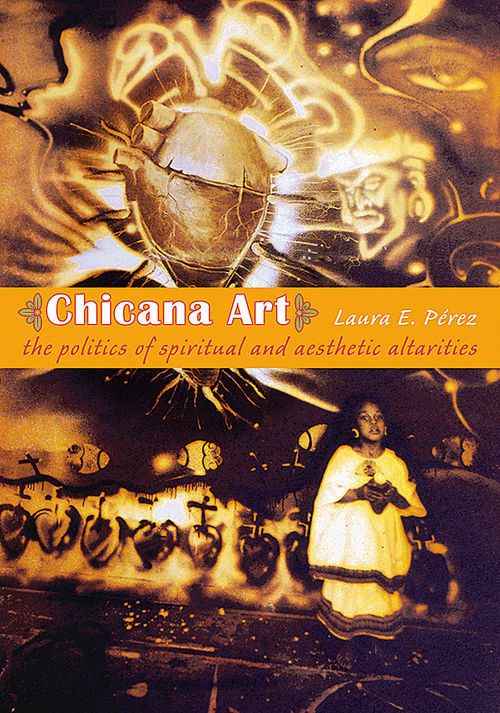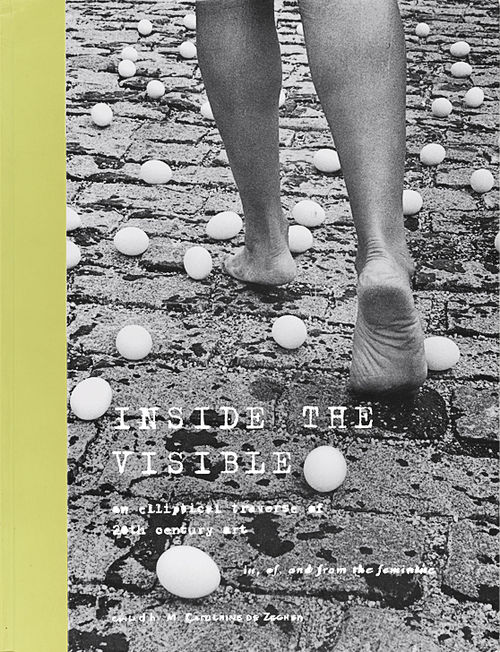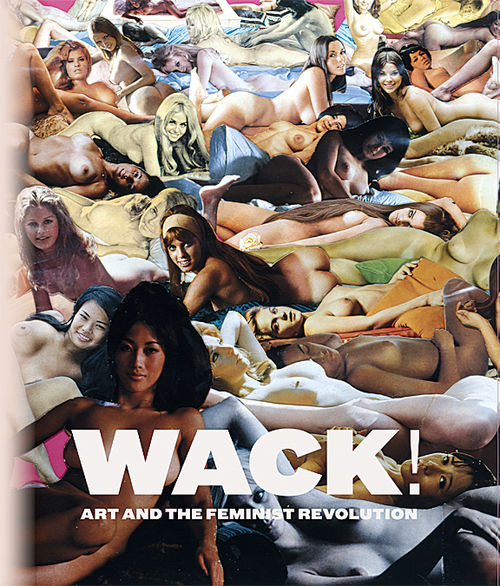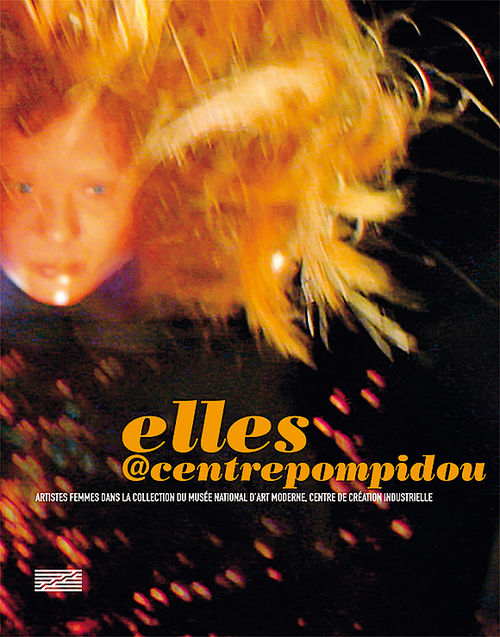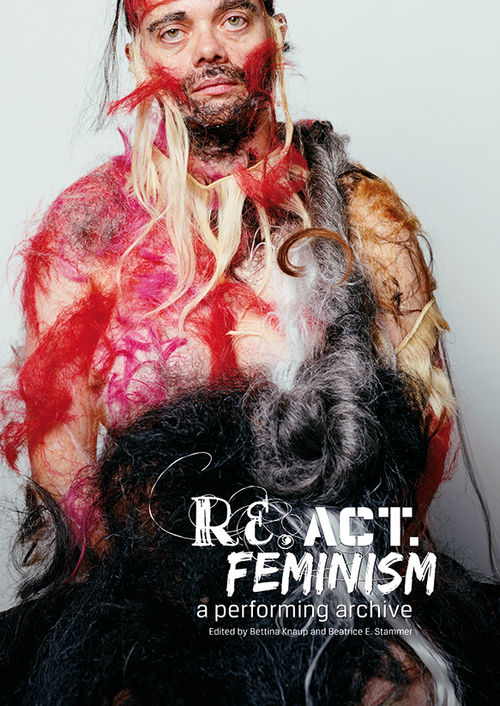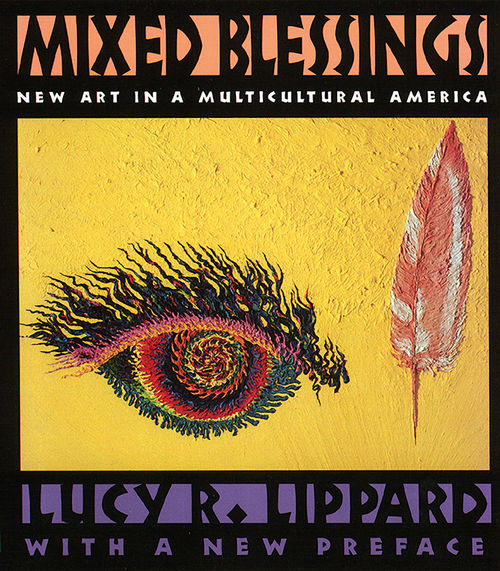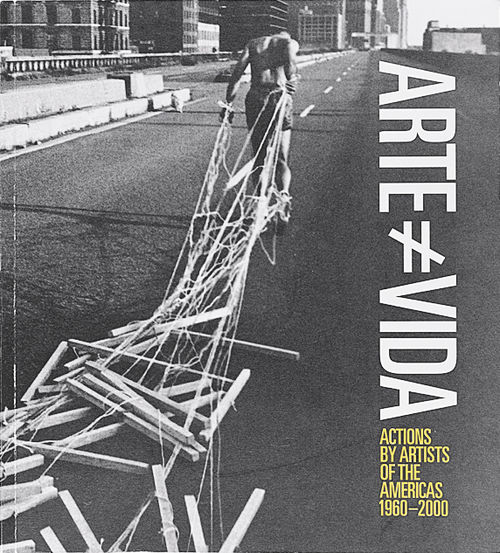The Invisibility of Latin American Women Artists
The very need to organize a historical exhibition based on gender is evidence of a vacuum in the art system. Women have been systematically excluded or presented in stereotypical and biased ways for centuries. This has created a situation that is difficult to address, partly because the opportunities to do so are still few and also because many of the same prejudiced and exclusionary frameworks still prevail today. The reality is that many more women artists participated in the shaping of twentieth-century art than have been accounted for. In Latin America this has been partly because of sexism and also because the system, both on the continent and internationally, judges the quality of artists' work on the basis of visibility and success, which are often denied to women. For example, the Mexican feminist artist Mónica Mayer (fig. 1), who has been working since the 1970s, was largely absent from the art system, finally receiving much-deserved recognition with a retrospective at the Museo Universitario Arte Contemporáneo in Mexico City in 2016. This is because the very idea of feminist art has been anathema for the art establishment in her country.# Ironically the qualities that have been celebrated in twentieth-century art—an antiestablishment stance, experimentalism, originality, and nonconformity—often do not apply when it comes to women artists. A key prejudice is that women artists are simply not as good as men, and from this follows a failure to ask the most crucial question in the field: Where are the women artists?#
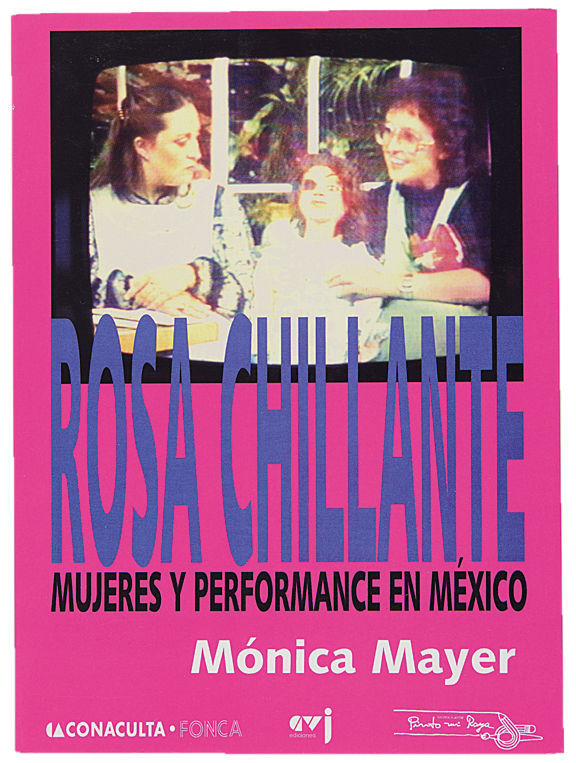
In the twentieth century Latin American women and Latina artists have actively shaped the artistic languages of their time. Nevertheless, in the art historical accounts and exhibitions that have served as the major references in the field, men are the configurers of art history.# Only a few women artists have been chosen to represent the field at large, and these figures have been highlighted again and again: Anita Malfatti, Tarsila do Amaral, and Amelia Peláez representing early modernism; Leonora Carrington, María Izquierdo, Frida Kahlo, and Remedios Varo for surrealism; Lygia Clark, Lygia Pape, Gego, and Mira Schendel for neoconcretism and geometric abstraction; and Ana Mendieta, Marta Minujín, and Liliana Porter for conceptual and experimental art. Fewer than twenty artists represent the hundreds of women artists, often unclassifiable, who are an intrinsic and important part of our history. Women artists have been made visible under the banners of surrealism,# geometric abstraction,# and more recently pop art.# All these movements allow for some form of erasure or fitting of women into existing parameters. Abstraction in particular is comfortable because of its apparent neutralizing or absence of gender issues.
Among the stereotypes that have defined women artists in Latin America is that of their very "invisibility," a tacit conviction that they are not good artists and therefore do not exist. Often women artists such as Mercedes Pardo (wife of Alejandro Otero) or Lola Alvárez Bravo (wife of Manuel Alvárez Bravo) have been made invisible simply by being the wives of recognized male artists. A widespread stereotype is that of the crazy, hysterical woman (mujer loca) and victim; such is the case with Frida Kahlo and, on occasion, Ana Mendieta. Also common is the notion of women as bad and kitsch artists, based on the idea that their aesthetic is often tasteless and unpalatable and that the issues they address (such as domesticity, sexuality, and social exclusion) are not important. Another pervasive misconception is that women's role as mothers precludes them from being relevant and committed artists.# Finally, any work associated with feminism has been viewed as bad art.#
Often male artists have been derisive toward their female colleagues, contributing to their isolation and invisibility. For example, Álvaro Barrios, in an interview with Miguel Ángel Rojas for his seminal book Orígenes del arte conceptual en Colombia, uses the example of Sara Modiano's supposed disappearance from the public art sphere around 1987 to demonstrate her lack of relevance and commitment to her art.# In reality Modiano never stopped working, and the proof of this is the many ideas and drawings that she continued to develop in her notebooks.#
Two crucial authors who have shaped Latin American art history are Marta Traba and Damián Bayón. Traba was hugely influential for decades in defining what Latin American art should be and therefore established a canon. In key books such as Dos décadas vulnerables en las artes plásticas latinoamericanas, 1950–1970 (1973) and in essays such as "La cultura de resistencia" (1971), she developed her ideas for an art of resistance, an art that was relevant to society and to its national and continental context.# She was against a neutral modern art that was mimetic of international trends such as kinetic art and much abstract art and therefore dependent and colonialist, and she also opposed any form of indigenism and folklorism. Traba lived in several countries in Latin America—including Colombia, Puerto Rico, Uruguay, and Venezuela—and in each location she explored and wrote intensively about local art. Although she wrote about several women for the press and for smaller catalogues and brochures, most of these artists were not included in the larger and more influential narratives of her books. There her protagonists were male artists, with the exception of Amelia Peláez.# Artists such as Beatriz González and Feliza Bursztyn were supported by Traba in Colombia but played a minor role in her larger Latin Americanist discourse.# In Venezuela she wrote about Tecla Tofano's work, but again the artist did not play an important role in her defining narrative.# Damián Bayón, in his book Aventura plástica de Hispanoamérica (1974), promotes artists such as Raquel Forner, María Luisa Pacheco, and Amelia Peláez while also mentioning a few other women artists as minor footnotes in a history dominated by men. Bayón did not favor surrealism: he describes Kahlo's work as "unhealthy" (enfermizo) and suggests that her craziness was "transmissible."# He was not against abstraction, so he briefly mentioned on a positive note artists such as Lilia Carrillo, Elsa Gramcko, Sara Grilo, and Luisa Richter. An important and unique publication on Latin American women artists from this period was the special issue of Artes visuales published by the Museo de Arte Moderno, Mexico City, in 1976 (fig. 2). The publication contained the proceedings of "Women/Art/Femininity," a conference organized by Carla Stellweg with contributions by Mexican, Latin American, and international feminists and intellectuals.#

Juan Acha played an important role between the 1970s and the 1980s in developing a theoretical framework for the experimental and conceptual expressions of the time in Latin America, particularly Peru and Mexico, taking a political and critical stance toward colonialist and market dependency. His influential terms arte no objetual and no-objetualismo (nonobjectivism) encompassed conceptual art, performance, actions, and live forms done in private, as well as new media, installation, site-specific art, ephemera, and traditional craft. Acha supported experimental artists in his country, Peru, including Teresa Burga's seminal Perfil de la mujer peruana (The profile of the Peruvian woman, 1981), which was included in the Primer coloquio latinoamericano de arte no-objetual y arte urbano, spearheaded by Acha, as well as other women artists, such as Lygia Clark, Marta Minujín, and Yeni y Nan. Despite Acha's open approach to art, he was not interested in gender issues or feminism.
Internationally there have been several surveys of Latin American art that have shaped the field. Art in Latin America: The Modern Era, 1820–1980, curated by Dawn Ades for the Hayward Gallery in London in 1989, featured work by 155 artists, only twelve of whom were women.# The celebration of the five hundredth anniversary of the discovery of America occasioned a series of exhibitions that continued the trend of showing only a few women artists, generally the "usual suspects," such as the survey Latin American Artists of the Twentieth Century at the Museum of Modern Art, New York, in 1993, curated by Waldo Rasmussen with the help of an important group of advisers, which included work by ninety-five artists, only fourteen of them women.#
Latin American Women Artists, 1915–1995, organized by the Milwaukee Art Museum in 1995 and curated by Geraldine P. Biller with the advice of Edward Sullivan and Bélgica Rodríguez, was the first and, until Radical Women: Latin American Art, 1960–1985, the only large-scale exhibition in the United States devoted to the topic.# It addressed the contributions of women artists to the development of twentieth-century Latin American art through a selection of thirty-five artists representing eleven countries.# Biller leaves it to the viewer to decide whether there is a common aesthetic among Latin American women artists and proposes via a series of descriptive clichés that their perspectives are different from those of their male counterparts. She refers to "the definition of the female body so sensitively constructed by Rocío Maldonado" and asks, "Would a male have chosen to depict a house in order to define his space as Elba Damast does hers, or a kitchen as Leonora Carrington does in Grandmother Moorhead's Aromatic Kitchen?"# Such statements point to the rationale for this show, emphasizing its role of revealing the unique nature of feminine expression and its importance in art history. The curator circumscribes the show within, on the one hand, Marta Traba's anachronistic conception of Latin American art, presented in Art of Latin America, 1900–1980, and, on the other, a conventional idea of the evolution of artistic tendencies.# Additionally, the specificity of gender is addressed through stereotypical ideas of the feminine. Despite the good intentions of the exhibition, it emphasizes generalized misunderstandings about women artists and did not truly advance or transform the field.
Toward the end of the 1990s and into the new millennium, there emerged a series of international and Latin American exhibitions and publications that brought to light the varied and prolific practices of women artists. In her 2008 essay, "Género y feminismo: Perspectivas desde América Latina," Andrea Giunta proposed an approach to Latin American art from a gender perspective.# In 2007 Karen Cordero Reiman and Inda Sáenz published a first-of-its-kind compilation on feminist theory in the Spanish language, Critíca feminista en la teoría e historia del arte.# In Colombia in 2004 Carmen María Jaramillo curated Otras miradas, an exhibition of work from the 1940s to 2004 by women artists from different generations,# and in Costa Rica in 2009 Virginia Pérez-Ratton curated an exhibition of three Central American artists, Tres mujeres tres memorias: Margarita Azurdia, Emilia Prieto, Rosa Mena Valenzuela, at Teorética. In 2006 Heloisa Buarque de Hollanda and Paulo Herkenhoff curated Manobras radicais for the Centro Cultural Banco do Brasil, São Paulo, to bring to light the audacity and innovation of Brazilian women artists in the twentieth and twenty-first centuries. In the United States in 2007 Laura E. Pérez published Chicana Art: The Politics of Spiritual and Aesthetic Alterities (fig. 3). During this period monographic studies and retrospective exhibitions were devoted to Teresa Burga, Feliza Bursztyn, Lygia Clark, Anna Maria Maiolino, Marta Minujín, Lygia Pape, Cecilia Vicuña, and many other women artists.#
A number of international exhibitions included Latin American women artists, such as Catherine de Zegher's seminal traveling exhibition Inside the Visible: An Elliptical Traverse of 20th Century Art in, of, and from the Feminine (1994; fig. 4); WACK! Art and the Feminist Revolution, curated by Connie Butler for the Museum of Contemporary Art, Los Angeles (2007; fig. 5);# Global Feminisms: New Directions in Contemporary Art, curated by Maura Reilly and Linda Nochlin for the Brooklyn Museum (2007);# and Elles@centrepompidou: Artistes femmes dans les collections du Musée national d'art moderne, curated by Camille Morineau (2009; fig. 6).# Re.act.feminism #2—a performing archive (fig. 7) was an unprecedented mobile archive curated by Bettina Knaup and Beatrice Ellen Stammer that traveled through six European countries between 2011 and 2013, which included artists from Eastern and Western Europe, the Mediterranean, the Middle East, the United States, and several countries in Latin America.# In 2013 the online magazine Artelogie, an initiative of the École des Hautes Études en Sciences Sociales in Paris, published an issue solely dedicated to feminism and art in Latin America, which included important articles on Mexico, Argentina, Chile, Brazil, and the Caribbean.#
The international exhibition artevida, curated by Adriano Pedrosa in association with Rodrigo Moura, took place at four separate institutions in Rio de Janeiro in 2014.# It explored the relationship between art and life, focusing on the period from the late 1950s to the early 1980s, using Brazilian art as a reference. Placing an important emphasis on the body—one of its four themes—it included works by a large number of women artists, among them the Brazilians Martha Araújo, Lygia Clark, Iole de Freitas, Anna Maria Maiolino, and Wanda Pimentel, as well as Latin American and international artists such as Helena Almeida, Geta Brătescu, Teresa Burga, Rosemarie Castoro, Gego, Zarina Hashmi, Birgit Jürgenssen, Dora Maurer, Ana Mendieta, Marisa Merz, Senga Nengudi, Yoko Ono, Yvonne Rainer, Lotty Rosenfeld, Zilia Sánchez, Annegret Soltau, and Cecilia Vicuña. This is perhaps the most ambitious international exhibition to date to propose an open and complex dialogue between Brazilian, Latin American, European (including Eastern European), and North American artists, in which women artists were seamlessly given a role equal in prominence to that of their male counterparts. It is important to note that even though the international exhibitions and publications discussed here gave new visibility to unknown women artists, the majority of them were nevertheless formulated under the banner of international feminism, without clarifying the difference between a feminist framework and actual feminist art. In fact, most of the Latin American women artists shown in these exhibitions do not consider their work to be feminist.
If Latin American women artists have been largely made invisible, Chicana and Latina artists have also been excluded from a larger dialogue within modern and contemporary art. There are many reasons for this. Latino and Chicano art is often defined by what it is not, that it is neither American art nor Latin American art. This assumption is based on misconceptions and stereotypical notions of what Latino and Chicano art might look like and refer to, racial prejudices about nation and identity, and false or limited conceptions of what a national art might be. Two phenomena have made a broader understanding of Latino art difficult. One is the emphasis on social issues (immigration, poverty, violence, inequality, etc.) and activism. The Chicano movement, for example, combined social activism with an idea of art and culture that is not mainstream and is considered problematic because it is not glamorous enough and is too politicized. The second is (Euro-American) multiculturalism in the 1980s, which promoted ideas of cultural essentialism, leading cultural, national, and ethnic "identitarian" obsessions to become pervasive in interpretations of Latin American and Latino art. Multiculturalism has been so widely demonized that it is challenging to recover its positive aspects, such as its promotion of a broader cultural dialogue between art practices in the Americas, as well as to analyze its lasting negative legacy. Latina and Chicana artists working in the United States were responding not only to patriarchal politics that were as oppressive as those faced by their counterparts in Latin America but also to a second-wave feminism that was often indifferent to the issues faced by women of color.
Many of the publications and exhibitions produced in the 1990s were true laboratories of inclusion and exchange. Lucy Lippard's Mixed Blessings: New Art in a Multicultural America (1990; fig. 8) promotes a broad dialogue across cultures and discusses a large number of Chicana, Latina, and Latin American artists, including Celia Álvarez Muñoz, Judith F. Baca, Yolanda López, Ana Mendieta, Amalia Mesa-Bains, Regina Vater, and Cecilia Vicuña.# Chicano Art: Resistance and Affirmation, 1965–1985, presented at the Wight Art Gallery of the University of California, Los Angeles, in 1990, was the first survey of Chicano art in the country and included works by forty-five women, including Álvarez Muñoz, Baca, Yreina D. Cervantez, and the Mujeres Muralistas. Shifra M. Goldman's Dimensions of the Americas: Art and Social Change in Latin America and the United States (1994; fig. 9) includes a section titled "Women Speaking," which comprises five essays discussing women artists such as Lourdes Grobet and Ana Mendieta as well as the Chicana artists Barbara Carrasco, Isabel Castro, Diane Gamboa, Ester Hernández, Judithe Hernández, and Yolanda López.# In the chapter "Mujeres de California," Goldman points to the fact that, despite the positive inclusion of Latina and Chicana artists in exhibitions, the ratio of Latina women to Latino men is dismally low. She writes, "The exclusions themselves are compounded for Latina women: later starts, less acceptance, sexism within their own ranks, sexism plus racism in the world at large."#
Moving into the new millennium, less identity-driven publications and exhibitions emerged in the field. Examples are Art/Women/California 1950–2000: Parallels and Intersections, the first survey of its kind, curated by Diana Burgess Fuller and Daniela Salvioni for the San Jose Museum of Art, which included work by many Latina artists and gave it a broad role within the larger context of the exhibition. Its catalogue includes three important chapters on Latina and Chicana artists, written by Amalia Mesa-Bains, Terezita Romo, and Jennifer González.# One of the most important exhibitions to bring together Latin American and Latino/a artists during the first decade of the millennium was Deborah Cullen's Arte ≠ Vida: Actions by Artists of the Americas, 1960–2000 (fig. 10), at the Museo del Barrio in New York in 2008. This show about performance incorporated works by twenty-seven women artists as well as others who participated in artist groups. Its catalogue discusses works by more than fifty-nine women artists and twenty-one groups that included women.# This publication demonstrates how broad, experimental, and dialogical the performance art scene had been since the 1960s.
In recent years conceptual art has become a focus of attention in Latin America.# Two scholars and curators who have championed the field are Luis Camnitzer and Mari Carmen Ramírez. Perhaps the most established and popular publication on the topic is Camnitzer's Conceptualism in Latin American Art: Didactics of Liberation (2007). He discusses only two women artists under a special heading: Lygia Clark, together with Hélio Oiticica, and Liliana Porter within the New York Graphic Workshop, of which Camnitzer was a member along with José Guillermo Castillo. In discussing Chile, Camnitzer includes Diamela Eltit within Colectivo de Acciones de Arte (CADA), Lotty Rosenfeld, and Cecilia Vicuña. Graciela Carnevale, Antonia Eiriz, Gego, Lourdes Grobet, Marta Minujín, Antonieta Sosa, and Silvia Torras are named briefly; Paz Errázuriz, Beatriz González, Margarita Paksa, and Lygia Pape are relegated to footnotes. Ramírez too has paid little attention to women artists within conceptualism. Her essay "Tactics for Thriving on Adversity: Conceptualism in Latin America, 1960–1980" includes a substantial discussion of Lygia Clark and mentions Graciela Carnevale, Noemí Escandell, Margarita Paksa, and Liliana Porter.# The criteria for conceptualism deployed by these authors are heroic, political, and even militant, leaving little space for those forms of conceptualism and experimental art that embrace more subjective interjections and both broad and intimate personal and political struggles. In the context of Radical Women, it is of particular relevance to note the general absence of women artists as shapers of conceptual and experimental art in Latin America between the 1960s and the 1980s, though I should stress the exception of Brazil and Chile# and, in recent years, Argentina, Peru, and to some extent Mexico.#
Although the disposition to replicate the system of exclusion persists, the field has changed immensely since the 1970s, and as we have seen, this is reflected in the production of new scholarship, art histories, and exhibitions that recognize women as original shapers of the broad field of modern and contemporary art. The very existence of Radical Women is proof of this, revealing how women artists active between 1960 and the mid-1980s, through daring and creative explorations of the poetics of the body and an engagement with social and political struggles, disrupted patriarchal structures to radically change art.
On this issue, see Mónica Mayer, Rosa chillante: Mujeres y performance en México (Mexico City: Conaculta/Fonca and AVJ, 2004), and Araceli Barbosa, Arte feminista en los ochenta en México: Una perspectiva de género (Mexico City: Casa Juan Pablos; Cuernavaca, Morelos: Universidad Autónoma del Estado de Morelos, 2008).
This question is related to Linda Nochlin's 1971 essay "Why Have There Been No Great Women Artists?," in Women, Art, and Power and Other Essays (New York: Harper & Row, 1988), 145–78, but it differs from it in that it is an affirmative question leading to a proactive inquiry.
This text does not pretend to be exhaustive in its references, nor does it include the literature about individual countries in Latin America.
For example, In Wonderland: The Surrealist Adventures of Women Artists in Mexico and the United States, curated by Ilene Susan Fort and Tere Arcq for the Los Angeles County Museum of Art in 2011, featured works by forty-eight Mexican and US-based women artists spanning more than four decades.
Inverted Utopias: Avant-garde Art in Latin America (New Haven, CT: Yale University Press; Houston: Museum of Fine Arts, 2004); The Sites of Latin American Abstraction (Milan: Charta; Miami: CIFO, 2006), and The Geometry of Hope: Latin American Abstract Art from the Patricia Phelps de Cisneros Collection (Austin: Blanton Museum of Art, University of Texas, 2007) are just a few examples of exhibitions that featured women artists working with geometric abstraction.
Arte de contradicciones: Pop, realismos y política; Brasil-Argentina 1960s, curated by Rodrigo Alonso and Paulo Herkenhoff for Fundación Proa, Buenos Aires, in 2012; The World Goes Pop, organized by the Tate, London; and International Pop, organized by the Walker Art Center, both in 2015, included work by some Latin American women artists.
Whitney Chadwick explains that, for example, the critic J. K. Huysmans attributed Mary Cassatt's ability to paint children to her gender rather than her artistic skills. She places this in the context of the division between the public sphere of the "Man of Reason" and the submissive woman in the domestic environment, which became normative in the nineteenth century. Chadwick, Women, Art, and Society, 4th ed. (London: Thames & Hudson, 2010), 40–41.
For a general discussion touching on this issue, see Lucy Lippard, "Sweeping Exchanges: The Contribution of Feminism to the Art of the 1970s," in The Pink Glass Swan: Selected Feminist Essays on Art (New York: New Press, 1995), 171–82.
The text reads:
Álvaro Barrios: Now that you mention Sara Modiano, I would like your opinion about artists who suddenly stop making art for a period of time and after many years start working again, or stop working altogether and dedicate themselves to other things. What do you think about this?
Miguel Ángel Rojas: I don't believe in these people. . . . To be an artist is like breathing!
Álvaro Barrios: In the case we mention, this person had a career, let's say, she participated at the Biennale of Sydney, for example.
Álvaro Barrios, "Conversación con Miguel Ángel Rojas," in Orígenes del arte conceptual en Colombia, 2nd ed. (Medellín: Museo de Antioquia, 2011), 121 (translation mine).
The notebooks are in the collection of the Fundación Sara Modiano para las Artes, Bogotá.
Marta Traba, "La cultura de resistencia," in Literatura y praxis en América Latina, ed. Fernando Alegría (Caracas: Monte Avila, 1971), 49–80.
The male artists include Fernando Botero, José Luis Cuevas, Wifredo Lam, Roberto Matta, Alejandro Obregón, Armando Reverón, Fernando de Szyzslo, and Rufino Tamayo.
Traba was generally more interested in women artists in the 1960s and 1970s than she was in the 1950s. In the 1950s she wrote positively about the artists Cecilia Porras, María Thereza Negreiros, and Lucy Tejada. Later on she was also responsive to artists such as Julia Acuña, Feliza Bursztyn, Beatriz Daza, Sonia Gutiérrez, Ana Mercedes Hoyos, and Nirma Zárate, though she was uninterested in Debora Arango. I thank Carmen María Jaramillo for her insight into Traba's approach to women artists in Colombia. In Propuesta polémica sobre arte puertorriqueño (Rio Piedras, PR: Librería Internacional, 1971), Traba dedicates a chapter to Myrna Báez ("Myrna Báez tras la barricada," 121–34).
Marta Traba, "Tecla Tofano ars política," El Nacional (Caracas), November 3, 1973; published in English in Gabriela Rangel and Jorge F. Rivas Pérez, eds., Moderno: Design for Living in Brazil, Mexico, and Venezuela, 1940–1978 (New York: Americas Society; Miami: Prisa/ Santillana, 2015).
Damián Bayón, Aventura plástica de Hispanoamérica: Pintura, cinetismo, artes de la acción (1940–1972) (Mexico City: Fondo de Cultura Económica, 1974), 128–29. He discussed Marta Minujín and described her work as "curious," and by 1973—when he was finishing the book—he declared that Minujín's trajectory "was shiny and fleeting" and that she was "burned out by her own success" and that North American companies that pay for absurd artistic experiences were no longer interested in her (274).
Carla Stellweg, ed.,"Mujeres, arte, femineidad," special issue, Artes visuales 9 (January–March 1976).
The women artists were Tarsila do Amaral, Leonora Carrington, Lygia Clark, María Izquierdo, Frida Kahlo, Anita Malfatti, Lygia Pape, Amelia Peláez, Alice Rahon-Paalen, Mira Schendel, Tilsa Tsuchiya, and Remedios Varo. Other international exhibitions involving Latin American art are Cartographies: 14 Latin American Artists, curated by Ivo Mesquita and Paulo Herkenhoff for the Winnipeg Art Gallery in 1993, which included three women artists out of fourteen in the show, and The Bleeding Heart, curated by Olivier Debroise for the Institute of Contemporary Art in Boston, which included six women out of eighteen artists. Five of the fifteen artists whose work was included in Ultrabaroque: Aspects of Post–Latin American Art, curated by Elizabeth Armstrong and Victor Zamudio-Taylor for the Museum of Contemporary Art San Diego in 2001, were women.
The women artists were Tarsila do Amaral, Frida Baranek, Leda Catunda, Lygia Clark, Gego, María Izquierdo, Frida Kahlo, Jac Leirner, Rocío Maldonado, Marisol, Ana Mendieta, Liliana Porter, Lidy Prati, and Mira Schendel. Edward Lucie-Smith's Latin American Art of the Twentieth Century (New York: Thames & Hudson, 1993) features the same kinds of omissions and includes usual suspects such as Tarsila do Amaral, Leonora Carrington, Lygia Clark, Raquel Forner, Gego, Frida Kahlo, Maria Luisa Pacheco, Amelia Peláez, Remedios Varo, and Tilsa Tsuchiya. The author, even though he purports to cover the entire twentieth century, takes a limited and stereotypical approach to Latin American art and leaves out conceptualism and experimental art almost entirely.
Because of the chronological span, the exhibition included a large number of artists, illustrating the evolution of most of the major trends of this time period, from Tarsila do Amaral, Raquel Forner, Frida Kahlo, Anita Malfatti, and Amelia Peláez, to abstract artists such as Lygia Clark, Gego, and Mira Schendel, to more contemporary artists such as Beatriz González, Jac Leirner, Ana Mendieta, Catalina Parra, and Liliana Porter.
Biller admits to being a "gringa" organizing a show for a mainstream US museum and describes the considerations that shaped the selection of artists, including artistic innovation and the "presence or absence of gender issues as expressed in the subject matter of each artist's work or in her life as an artist." Geraldine P. Biller, Latin American Women Artists / Artistas latinoamericanas, 1915–1995 (Milwaukee: Milwaukee Art Museum, 1995), 19.
Ibid., 21.
Marta Traba, Art of Latin America, 1900–1980 (Baltimore: Inter-American Development Bank, 1994). Traba summarizes her overarching vision of Latin American art, which by the mid-1990s was somewhat retrograde and conventional. It included the same artists she defended in the 1970s and 1980s and paid little attention to experimental practices.
Andrea Giunta, "Género y feminismo: Perspectivas desde América Latina," Exit Book (Madrid), no. 9 (2008): 90–95.
Karen Cordero Reiman and Inda Sáenz, Critica feminista en la teoría e historia del arte (Mexico City: Universidad Iberoamericana, UNAM, Programa Universitario de Estudios de Género, Consejo Nacional para la Cultura y las Artes, FONCA, and CURAR, 2007). Since the mid-2000s there has been pioneering research in the fields of feminist art and women artists in Latin America. On Mexico, see Mayer, Rosa chillante, and Barbosa, Arte feminista, as well as the encyclopedic exhibitions Historia de mujeres artistas en México del siglo XX, curated by Germaine Gómez and Miguel Cervantes for the Museo de Arte Contemporáneo de Monterrey in 2008, and Mujeres detrás de la lente: 100 años de creación fotográfica en México 1910–2010, curated by Emma Cecilia García Krinsky in 2012. On other Latin American countries, see Julia Antivilo Peña, "Entre lo sagrado y lo profano se tejen rebeldías: Arte feminista latinoamericano; México, 1970–1980" (MA thesis, Centro de Estudios Culturales Latinoamericanos, Facultad de Filosofía y Humanidades, Universidad de Chile, 2006); Andrea Giunta, "Mujeres entre activismos: Una aproximación comparativa al feminismo artístico en Argentina y Colombia," Caiana: Revista de historia del arte y la cultura visual, no. 4 (2014), http://caiana.caia.org.ar/template/caiana.php?pag=articles/article_2 .php&obj=149&vol=4; María Laura Rosa, Legados de libertad: El arte feminista en la efervescencia democrática (Buenos Aires: Biblos, 2014); Carmen María Jaramillo, Mujeres entre líneas: Una historia en clave de educación, arte y género (Bogotá: Museo Nacional, 2015). On the issue of feminist art and gender, see the text by Julia Antivilo Peña, Mónica Mayer, and Maria Laura Rosa, as well as Andrea Giunta's "The Iconographic Turn," both in this volume.
The artists are Débora Arango, Patricia Bravo, Johanna Calle, María Fernanda Cardoso, Clemencia Echeverri, María Elvira Escallón, Beatriz González, Delcy Morelos, Gloria Posada, and Libia Posada.
My focus here is institutional exhibitions, so I do not discuss artist-organized exhibitions addressing gender issues, such as the two Mitominas exhibitions (1986, 1988), which were restaged in Mitominas: 30 años después, curated by María Laura Rosa at Centro Cultural Recoleta, Buenos Aires, in 2016.
WACK! included works by Sonia Andrade, Judith Baca, Lygia Clark, Iole de Freitas, Lea Lublin, Anna Maria Maiolino, Mónica Mayer, Ana Mendieta, Catalina Parra, Mira Schendel, and Cecilia Vicuña.
Global Feminisms included works by Tania Bruguera, Regina José Galindo, Teresa Margolles, Priscilla Monge, and Adriana Varejão.
Important publications have maintained a traditional approach to the female/male ratio. For example, Jacqueline Barnitz in her book Twentieth-Century Art of Latin America (Austin: University of Texas Press, 2001) mentions a considerable number of women artists, though she highlights only a few (especially in comparison to their male counterparts) common names and trends: Anita Malfatti and Tarsila do Amaral for the avant-garde of the 1920s, the surrealist artists Leonora Carrington, Raquel Forner, María Izquierdo, Frida Kahlo, and Remedios Varo; and the neoconcrete artists Lygia Clark and Lygia Pape. Gerardo Mosquera's Contemporary Art in Latin America (London: Blackdog, 2010) discusses only eleven women out of fifty artists.
The archive included artists active between the 1960s and the 1980s: Margarita Azurdia, Tania Bruguera, Maris Bustamante, Graciela Carnevale, Lygia Clark, Teresa María Díaz Nerio, Diamela Eltit, Coco Fusco, Regina José Galindo, Anna Bella Geiger, María Teresa Hincapié, Lea Lublin, María Evelia Marmolejo, Mónica Mayer, Ana Mendieta, Marta Minujín, Letícia Parente, Polvo de Gallina Negra, Jesusa Rodríguez / Liliana Felipe, Antonieta Sosa, Cecilia Vicuña, and Yeni y Nan.
See, for example, Andrea Giunta, "Feminist Disruptions in Mexican Art, 1975–1987," Artelogie: Recherches sur les arts, le patrimoine et la littérature de l'Amérique Latine, no. 5 (2013), http://cral.in2p3.fr/artelogie /spip.php?rubrique39.
Adriano Pedrosa, ed., Artevida, vol. 1 (São Paulo: Cobogó, 2015).
Lucy Lippard, Mixed Blessings: New Art in a Multicultural America (New York: Pantheon, 1990). The book discusses Celia Álvarez Muñoz, Asco, Judith F. Baca, Santa Barraza, María Brito, Josely Carvalho, Cristina Emmanuel, María Enríquez de Allen, Marina Gutierrez, Ester Hernández, Yolanda López, Ana Mendieta, Amalia Mesa-Bains, Catalina Parra, Liliana Porter, Sophie Rivera, Patricia Rodríguez, Merián Soto, Kathy Vargas, Regina Vater, and Cecilia Vicuña.
Shifra M. Goldman, Dimensions of the Americas: Art and Social Change in Latin America and the United States (Chicago: University of Chicago Press, 1994), 177–241.
Ibid., 234.
Diana Burgess Fuller and Daniela Salvioni, eds., Art/Women/ California, 1950–2000: Parallels and Intersections (Berkeley: University of California Press; San Jose: San Jose Museum of Art, 2002). Another relevant example is L.A. Xicano—a project curated by Chon Noriega, Terezita Romo, and Pilar Tompkins Rivas as part of the Getty's initiative Pacific Standard Time: Art in L.A. 1945–1980 in 2011—which consisted of five interrelated exhibitions in Los Angeles. A large number of women artists of Mexican descent were included: Judith F. Baca, Barbara Carrasco, Yreina Cervantes, Dora de Larios, Sandra de la Loza, Isabel Castro, Elsa Flores, Judithe Hernández, Norma Montoya, Nancy Tovar, Linda Vallejo, Patssi Valdez, and Lucila Villaseñor Grijalva. See Chon Noriega, Terezita Romo, and Pilar Tompkins Rivas, eds., L.A. Xicano (Los Angeles: UCLA Chicano Studies Research Center Press, 2011).
Among the artists included were Tania Bruguera, Nao Bustamante, CADA, Lygia Clark, Coco Fusco, Regina José Galindo, Teresa Margolles, Ana Mendieta, Marta Minujín, and Lotty Rosenfeld. Deborah Cullen also organized the exhibition Nexus New York: Latin/American Artists in the Modern Metropolis in 2009, focusing on key Caribbean and Latin American artists who traveled to and resided in New York during the early decades of the twentieth century and participated in artistic dialogues. The show included works by María Izquierdo, Frida Kahlo, Anita Malfatti, Maria Martins, and Amelia Peláez.
An illuminating example of this is the exhibition Perder la forma humana: Una imagen sísmica de los años ochenta en América Latina, curated by the Red Conceptualismos del Sur for the Museo Nacional Centro de Arte Reina Sofía, Madrid, in 2012 and accompanied by a publication of the same title (Madrid: Museo Nacional Centro de Arte Reina Sofía, Departamento de Actividades Editoriales, 2012). According to the exhibition checklist published in the catalogue, out of a total of 178 artists in the exhibition, 110 are men, 54 are collectives, and 14 are women.
Mari Carmen Ramírez, "Tactics for Thriving on Adversity: Conceptualism in Latin America, 1960–1980," in Global Conceptualism: Points of Origin, 1950s–1980s (New York: Queens Museum of Art, 1999), 53–71.
Women artists, together with the cultural theorist Nelly Richard, were central to the political conceptual art scene in Chile. See Andrea Giunta's essay on Chile in this volume.
For example, see Obras son amores: Arte-Vida-México, 1964–1992, curated by Marisol Arguellas and Luis Orozco, at the Museo de Arte Moderno in Mexico City in 2014. See also Karen Cordero Reiman's essay in this volume.



